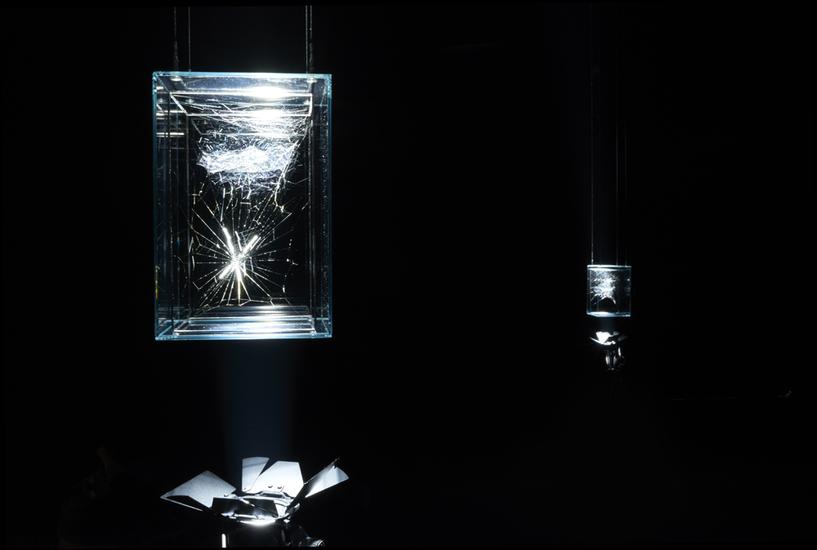Neijina, Barbara
Radiant Will O' the Wisp 1990 Media: Sculpture Dimensions: 15' x 25' x 25' Location: Entomology/ Nematology Building |
Art and Spiders
Sunday, December 20, 2015
Art in the Courtyard
Tuesday, November 3, 2015
Library of Questions
This is the Library of Questions
A portable library of questions, discoveries, and answers to be kept in the lab for all to use. Questions will be categorized by subject. There is no limit to the amount of questions and answers that will be included in the archive, once full any questions that are no longer interesting or useful will be eliminated to make way for new ones.
Please take a card and write a question to add to the collection. You may file it in the category you feel it most belongs: Spider, Science, Art.
These questions are based on anything you know, want to know, or has been on you mind. You can write the card with yourself in mind and try to answer it at a later time, or create for one others to respond to.
Front view
In the lab
a sample image of the cards
On working with spider silk
Spider silk as a material has been experimented with for some time now. Here is some information I've gathered on one way to start working with it in thread form.
The best kinds of webs in the southern US for silk gathering come from the following spiders;
1) golden orb spider,
2) black and yellow orb spider,
3) crab orb spider,
4) orchard spider
These spiders have webs with a lot of strong material to harvest, and are not venomous.
Their webs will be elevated on trees or shrubs, and should only be harvested if they are abandoned by the spider. An easy way to tell is to gently shake the limb the web is attached to, and make sure that no spider is present (they will come to check their web if they were hiding nearby).
Collect the web on a small smooth stick or other object and carefully wind it up on the stick in a loose manner. Using tweezers, clean the web of debris and untangle the fibers. Begin twisting the fibers together, overlapping them by three inches to combine lengths. Afterwards, spin the thread by taking two lengths and twisting them into each other, alternating one thread at a time. Fold the finished length in half and double it on itself to make it stronger.
A recent application produced a tapestry made entirely of Golden Orb Spider silk, and is the only large textile made entirely of natural spider silk.
http://www.wired.com/2009/09/spider-silk/
Colin Hutton Photography
Janet Iwasa: How animations can help scientists test a hypothesis
3D animation can bring scientific hypotheses to life. Molecular biologist (and TED Fellow) Janet Iwasa introduces a new open-source animation software designed just for scientists.
Thursday, September 17, 2015
TOMÁS SARACENO: COSMIC JIVE. THE SPIDER SESSIONS
Cosmic Jive: The Spider Sessions, 2014
“Even though spider webs have been around for at least 140 million years, we have never managed to preserve and display their webs in a three dimensional form. In fact, there is no single museum in the world with a collection of this kind. Tomás Saraceno’s spider web sculptures are a breakthrough in both science and art, and thanks to his methods new fields of studies have been opened.”
(Peter Jäger, 2015)
“[…] (R)emarkable feature of Saraceno’s work is that such a visual experience is not situated in any fixed ontological domain, nor at any given scale: you can take it, as I do, as a model for social theory, but you could just as well see it as a biological interpretation of the threads that hold the walls and components of a cell, or, more literally, as the weaving of some monstrously big spider, or the utopian projection of galactic cities in 3D virtual space. This is very important if you consider that all sorts of disciplines are now trying to cross the old boundary that has, until now, distinguished the common destiny of increasing numbers of humans and non-humans.”
(Bruno Latour, Some Experiments in Art and Politics, e-flux journal, #23, 03/2011)
Saraceno is a multidisciplinary artist from Argentina who currently lives and works in Berlin. The images above are select images from his Cosmic Jive installation, featuring sculptures containing the webs of spiders that have been illuminated by bright lights in a dim room. As beautiful as the work is, it's equally valuable as a scientific investigation. No museum has a collection of real and complete spider web structures. These webs, whole and authentic, are a fantastic display of webs construction that provides scientists with a specimen for study. Not only for aesthetic enjoyment, Saraceno himself has studied, scanned, mapped, and re-constructed the webs. He has created a 1:16 scale model of the web of a Latrodectus mactans (Black Widow) spider as an installation work with the help of a team of scientists and advanced imaging technology. Other applications of this series, including musical and sonic creations as well as intensive scientific exploration are talked about in great detail on the project page for this work, found here.

IN ORBIT, K21 STÄNDEHAUS, DÜSSELDORF, 2013

INSTALLATION VIEW, HANGAR BICOCCA, MILAN, 2012

GALAXIES FORMING ALONG FILAMENTS, LIKE DROPLETS ALONG THE STRANDS OF A SPIDERS WEB
JUNE 07 – NOVEMBER 22, 2009
VENICE BIENNALE, GIARDINI
Subscribe to:
Comments (Atom)



















